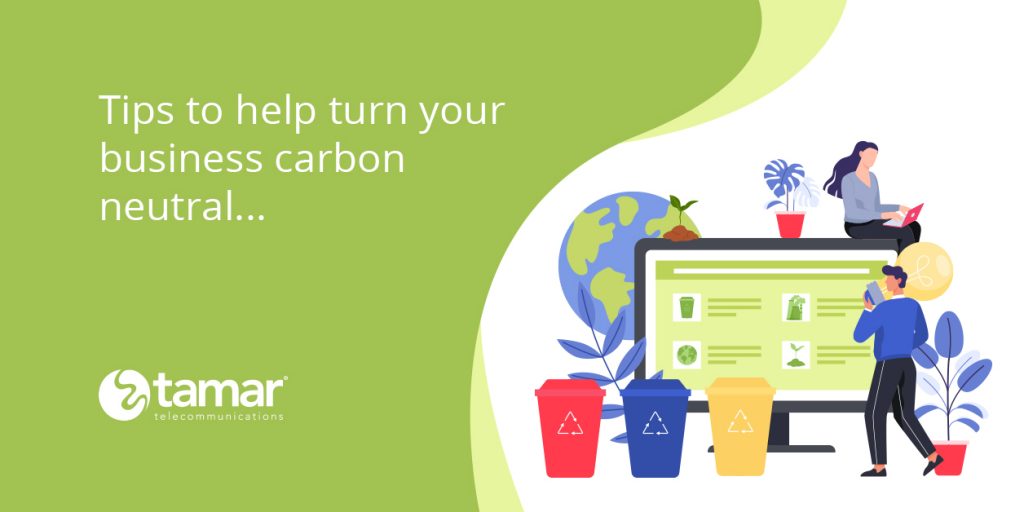This article provides tips on how to turn your business carbon neutral. We’ll take you through a three-stage process, from calculating your company’s carbon footprint, through implementing measures to reduce your carbon emissions, to setting up carbon offsetting programmes.

Calculate your company’s carbon footprint
In order for your business to work towards carbon neutrality, you will first need to calculate its carbon footprint. Doing this will help you estimate the volume of carbon emissions the business is currently creating.
Carbon Trust’s SME Carbon Footprint Calculator is an easy, effective and free-of-charge way to calculate your business’s carbon emissions. The tool will ask you to give information on things like your fuel consumption, energy consumption and air conditioner usage, all via a simple online tool.
It’s worth noting that the Carbon Trust’s calculator factors in only some of the carbon emissions sources common to small and medium businesses. Using the tool is a great starting point, but if you want a more precise calculation that could qualify your business for carbon neutral certification, you will need to pay for an in-depth carbon emissions audit further down the line.
Take steps to reduce your carbon emissions
Taking measures to reduce your business’s carbon emissions can help make the goal of carbon neutrality achievable. Let’s take a look at some top tips to bring your emissions baseline down.
Emissions reduction tip #1: encourage use of green transport options
There’s a good chance that at least some of your team members need to travel for work, whether that’s to and from your office, or to other locations. If this is true of your team, then you may be able to reduce your emissions significantly by encouraging your staff to make low-carbon transport choices.
One popular method is setting up a cycle-to-work scheme. Common features of these bicycle-focused campaigns include offering employees a contribution towards the cost of a bike, hosting cycle maintenance workshops, and providing ‘pool bikes’ which employees can borrow for short-term use.
Another important green transport step is encouraging the use of car pooling among employees, either through incentives, or where appropriate, through instructions.
Emissions reduction tip #2: do more remote working
Under certain conditions, remote working can reduce a business’s carbon footprint, by cutting out the emissions caused by employees’ travel to work and reducing energy consumption at the office.
This comes with the caveat that remote working may only reduce emissions if the employee uses a green alternative to office-based working. This might mean working at a co-working space close to their home, or working from home while using a green energy provider.
Businesses aiming to do more remote working should look to technologies such as project management software and video conferencing to facilitate meetings that would formerly have happened face-to-face. Many employees find this approach just as accommodating as working from the office, if not more so.
If remote working turns out to be a good fit for your business, you may eventually decide to close a bricks-and-mortar location, potentially saving a significant volume of emissions in the process. Businesses that choose this option can retain a sense of physical presence by setting up a virtual office address and local telephone number.
Emissions reduction tip #3: make your office greener
Remote working isn’t right for every business. Thankfully, there are lots of ways to make a workplace more eco-friendly, from using recycled ink cartridges to provisioning your canteen with sustainably-sourced ingredients.
Perhaps the most important thing you can do to reduce your premises’ emissions is switch to an energy provider that generates its energy from a renewable source, such as solar or wind. Green energy providers in the UK include OVO and Bulb.
Some offices go as far as to generate their own energy using solar panels or wind turbines, which can be an excellent way to cut down on emissions, given the right weather conditions.
Of course, methods to reduce emissions at the workplace doesn’t have to be as radical as installing an energy source on the roof. Simple steps like ensuring lights are switched off at night and using heating sparingly can make a big difference too.

Achieve carbon neutrality through carbon offsetting
No matter how much you manage to reduce your carbon emissions by, your business is bound to create some sort of carbon footprint. So, once you’ve worked out what your carbon emissions will be, after taking steps to bring emissions down, you’ll need to do something called carbon offsetting to achieve carbon neutrality.
Carbon offsetting means doing things that reduce the carbon emissions in the environment, in order to offset the effect of the emissions you put into it. The most popular offsetting method for businesses is tree planting. Every tree you plant should take in carbon-dioxide and put out oxygen in its place, which has the effect of cleaning up the atmosphere. If you’re interested in setting up a tree planting scheme for your business, get some help from a specialist organisation like Trees For Life.
Some businesses offset some of their carbon emissions by virtue of the positive ecological effect of the products or services they provide. For example, if a product educates consumers on how to recycle effectively, this can be seen as offsetting the business’s carbon emissions – although the benefit may be hard to quantify precisely.
You’re making a difference
The great thing about aiming for carbon neutrality as a business, is that even if you fail to reach full neutrality, you can still make a positive difference, relative to a business that doesn’t make any effort to curb its carbon emissions. Becoming carbon neutral is a great aspiration for any business – and any step you can take towards that goal is good news too.







